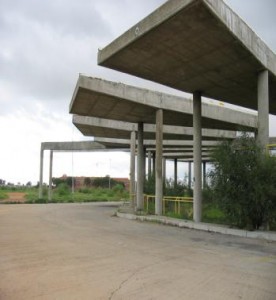China Allocates 20k Hectares for Low-Income Housing
chinadaily.com. August 8, 2012. BEIJING — China has allocated more than 20,000 hectares of land to support the construction of low-income housing this year, an official with the Ministry of Land and Resources said Tuesday.
The nation plans to distribute 47,600 hectares of land for low-income housing projects in 2012, more than the 43,600 hectares allocated last year, Vice-Minister Hu Cunzhi said at a seminar on low-income housing policies.
China has stepped up the construction of low-income housing in recent years, as skyrocketing home prices have triggered public complaints.
Housing prices have shown signs of rebounding over the last few months, after the government eased its grip over credit control to buoy the slowing economy.
The government has maintained its previously-adopted tightening measures such as higher down payments and property tax trials to cap home prices.
It has vowed to build 36 million affordable housing units during the 2011-2015 period to meet the demand from low-income families. In 2011, it started construction on 10 million units.
Read more: China Allocates 20k Hectares for Low-Income Housing
– With Links to More Stories to China’s Housing Policy
Vivek Wadhwa – In Chile’s Slums, a Lesson in How to Make Apps for Social Good
www.washingtonpost.com. April, 2, 2012 – How many of the hundreds of thousands of mobile phone applications seek to do truly great things, such as lift people out of poverty or improve health care for the poor?
The App Economy, to date, has largely touched the lives of those living in the developed world. This is due, in part, to the high cost of smart phones but also because app development has lacked real vision and purpose. I have found that Silicon Valley, generally speaking, doesn’t build apps to save the world or lift people out of poverty. It builds them to sell Angry Bird t-shirts and generate lots of virtual currency.
The folks at Centro de Innovación in Santiago, Chile, aim to change that.
I met Julian Ugarte, an Industrial designer, and his team during a recent trip to South America, and I was blown away by what they are trying to do. On March 22, Ugarte and Centro de Innovación launched a contest with Movistar — a mobile subsidiary of Telefonica — and TechoLab, a non-profit subsidiary of Un Techo para mi País (UTPMP) — a pan-Latin American NGO that dispatches youth volunteers on projects to eradicate the extreme poverty that affects tens of millions in Latin America. A $10,000 prize will be given to each of the creators of the best three apps that address problems facing the millions of people living at the bottom of the pyramid (BoP).
Read more: V. Wadhwa – In Chile’s Slums a Lesson in How to Make Apps for Social Good
Awareness Is Power: Tactics For Staying Safe In Violent Spaces
Violence is everywhere (Lindiwe, Hector Peterson Residence).
In order to understand the concept ‘awareness’, Hastrup’s (1995) explanation of consciousness is invaluable, especially to identify with people’s behaviour in violent situations. She explains that our patterns of thinking are not subject to paths of practical reason, but that we rather constantly reformulate our whole existence through our actions; a reconsideration of our ideas of consciousness is thus necessitated (ibid.: 99). Hastrup reminds us that we are inarticulate and that expression is not limited to the verbal. Expression, rather, takes place in various forms (ibid.).
Given Hastrup’s suggestion to understand consciousness from multiple angles, we approach a field within which questions of ontology and methodology join: how do people think and how do we know? (ibid.; Ross 2004: 35). What tools should anthropologists use to access these forms of consciousness that are so intertwined in social space, affecting it, being affected by it and being its defining capacity? In an environment of violence, students are affected, they can potentially have an influence on this through the tactics they use to stay safe and, at the same time, can become the defining capacity of such an environment. These are among the dynamics involved in conceptualising ‘awareness’ of potential danger in potentially dangerous areas. This awareness is positioned on various levels.
Brock Onque – The Implications of Public Housing Design: A Study of HUD’s Hope VI Program
Ph.D. – University of Pittsburgh, 2007.
Over the past decade a philosophy has emerged at HUD that recognizes the importance of good design in the development of public housing. Quality design can help create safe, reasonably scaled, defensible environments. A Federal Grants Program, Hope VI, was developed in 1993 under the Urban Revitalization Demonstration Program. This program allocates grants up to $50 million dollars for redesigning and making infrastructural improvements in public housing communities. Since the inception of the program, funds have been awarded to a total of 130 public housing authorities in 34 states, the District of Columbia, and the Virgin Islands. After more than a decade, what are the outcomes of the program – particularly in terms of creating safe environments and getting away from the negative stereotypes (both real and perceived) that are associated with public housing? Factually speaking, funds from the program have demolished 97,000 severely distressed public housing units, and there have been 61,000 revitalized units. But, in terms of other issues like safety, accessibility, and civic engagement, how has the program fared? One recent HUD study concludes that it is possible for this program to go wrong. The danger exists that the innovation of Hope VI could devolve into a new set of stereotypes comparable to some of the old public housing stereotypes. If the projects are poorly administered, buildings could deteriorate and public spaces could become neglected. Read more
Bruno Losch et al – Structural Transformation and Rural Change Revisited: Challenges for Late Developing Countries in a Globalizing World
 worldbank.org. Bruno Losch, Sandrine Freguin-Gresh, Eric Thomas White – Structural Transformation and Rural Change Revisited: Challenges for Late Developing Countries in a Globalizing World
worldbank.org. Bruno Losch, Sandrine Freguin-Gresh, Eric Thomas White – Structural Transformation and Rural Change Revisited: Challenges for Late Developing Countries in a Globalizing World
This book makes a compelling case for reintegrating structural issues into agricultural and rural development policies, which have for the last 30 years over-focused on short-term issues. It shows how the liberalization of agriculture in many late developing countries has not in fact led to the development of the vibrant rural non-farm economy, nor has it led to a large-scale integration of agricultural producers into the global economy. Despite these findings, the book draws optimistic conclusions: there are a clear set of policy priorities that, if adapted to individual country contexts, can facilitate an enduring and productive rural transformation.
The book is based on an in-depth seven-country study that surveyed 8,000 rural households. It specifically focuses on these households’ activity and income structures in an evolving agricultural context marked by liberalization and trends of increasing economic integration. In doing so it reviews the very different levels (and trajectories) of rural diversification among countries at various stages in the structural transformation process. Read more
Moladi – Innovations in Affordable housing
Siemens Stiftung. July, 11, 2012. Decent housing is one of the key factors in the fight against poverty and social exclusion. It is not just about putting a roof over someone’s head. Academic research proves that access to a clean and stable home implicates an improvement in security, health and education.
Moladi, a South African based company, makes housing accessible to low-income people through innovative and eco-friendly technology. The Moladi system consists of a reusable and recyclable plastic formwork mould, which is filled with stoneless cement and a special chemical additive. This additive ensures that, once the mortar is set, the framework can be removed – and reused up to 50 times. According to the founder Hennie Botes, the brickless walls can withstand all types of weather. The formwork is lightweight allowing easy transportation. Due to the simplicity in design and the repetitive application scheme, construction costs can be reduced significantly. The Moladi model is not only cost-effective but fast, too: Botes comments that the wall structure of a house can be completed within one day. A further plus point, especially in remote areas, is that the construction does not require heavy machinery or electricity.
Read more: Empowering People Award. Siemens Stiftung.org : Moladi




